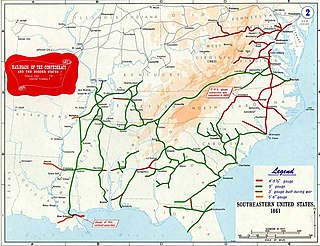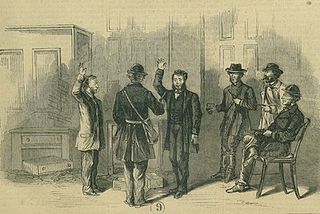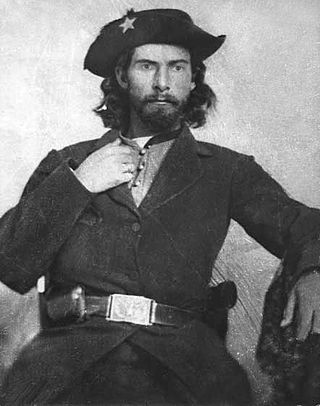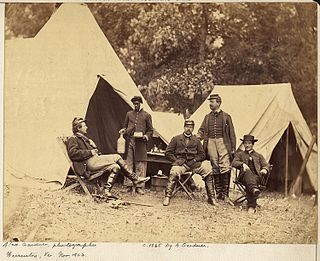Related Research Articles

John Hunt Morgan was an American soldier who served as a Confederate general in the American Civil War of 1861–1865.

John Singleton Mosby, also known by his nickname "Gray Ghost", was a Confederate army cavalry battalion commander in the American Civil War. His command, the 43rd Battalion, Virginia Cavalry, known as Mosby's Rangers or Mosby's Raiders, was a partisan ranger unit noted for its lightning-quick raids and its ability to elude Union Army pursuers and disappear, blending in with local farmers and townsmen. The area of northern central Virginia in which Mosby operated with impunity became known as Mosby's Confederacy. After the war, Mosby became a Republican and worked as an attorney, supporting his former enemy's commander, U.S. President Ulysses S. Grant. He also served as the American consul to Hong Kong and in the U.S. Department of Justice.

Quantrill's Raiders were the best-known of the pro-Confederate partisan guerrillas who fought in the American Civil War. Their leader was William Quantrill and they included Jesse James and his brother Frank.

The Great Locomotive Chase was a military raid that occurred April 12, 1862, in northern Georgia during the American Civil War. Volunteers from the Union Army, led by civilian scout James J. Andrews, commandeered a train, The General, and took it northward toward Chattanooga, Tennessee, doing as much damage as possible to the vital Western and Atlantic Railroad (W&A) line from Atlanta to Chattanooga as they went. They were pursued by Confederate forces at first on foot, and later on a succession of locomotives, including The Texas, for 87 miles (140 km).

The American Civil War was the first in which large armies depended heavily on railroads to bring supplies. For the Confederate States Army, the system was fragile and was designed for short hauls of cotton to the nearest river or ocean port. During the war, new parts were hard to obtain, and the system deteriorated from overuse, lack of maintenance, and systematic destruction by Union raiders.

The St. Albans Raid was the northernmost land action of the American Civil War. It was a raid from the Province of Canada by 21 Confederate soldiers. They had recently failed in engagements with the Union Army and evaded subsequent capture in the United States. The mission was to rob banks to raise money, and to trick the Union Army into diverting troops to defend their northern border against further raids. It took place in St. Albans, Vermont, on October 19, 1864. They got the money, killed a local, and escaped back to Canada.

Bushwhacking was a form of guerrilla warfare common during the American Revolutionary War, War of 1812, American Civil War and other conflicts in which there were large areas of contested land and few governmental resources to control these tracts. This was particularly prevalent in rural areas during the Civil War where there were sharp divisions between those favoring the Union and Confederacy in the conflict. The perpetrators of the attacks were called bushwhackers. The term "bushwhacking" is still in use today to describe ambushes done with the aim of attrition.
The trans-Mississippi theater of the American Civil War was the scene of the major military operations west of the Mississippi River. The area is often thought of as excluding the states and territories bordering the Pacific Ocean, which formed the Pacific coast theater of the American Civil War (1861–1865).

The Colorado Territory was formally created in 1861 shortly before the bombardment of Fort Sumter sparked the American Civil War. Although sentiments were somewhat divided in the early days of the war, Colorado was only marginally a pro-Union territory. Colorado was strategically important to both the Union and Confederacy because of the gold and silver mines there as both sides wanted to use the mineral wealth to help finance the war. The New Mexico Campaign was a military operation conducted by Confederate Brigadier General Henry Sibley to gain control of the Southwest, including the gold fields of Colorado, the mineral-rich territory of Nevada and the ports of California. The campaign was intended as a prelude to an invasion of the Colorado Territory and an attempt to cut the supply lines between California and the rest of the Union. However, the Confederates were defeated at the Battle of Glorieta Pass in New Mexico and were forced to retreat back to Texas, effectively ending the New Mexico Campaign.

The 43rd Virginia Cavalry Battalion, also known as Mosby's Rangers, Mosby's Raiders, or Mosby's Men, was a battalion of partisan cavalry in the Confederate Army during the American Civil War. Noted for their lightning strike raids on Union targets and their ability to consistently elude pursuit, the Rangers disrupted Union communications and supply lines.
The Battle of Loudoun Heights was a small cavalry skirmish during the American Civil War between John Mosby's Rangers and Major Henry A. Cole's 1st Potomac Home Brigade Maryland Cavalry on January 10, 1864, in Loudoun County, Virginia. Cole's Cavalry successfully defended a night raid against their camp on Loudoun Heights. The fight was one of the first engagements in which Union forces held their own against Mosby's vaunted partisans.

During the American Civil War, most of what is now the U.S. state of Oklahoma was designated as the Indian Territory. It served as an unorganized region that had been set aside specifically for Native American tribes and was occupied mostly by tribes which had been removed from their ancestral lands in the Southeastern United States following the Indian Removal Act of 1830. As part of the Trans-Mississippi Theater, the Indian Territory was the scene of numerous skirmishes and seven officially recognized battles involving both Native American units allied with the Confederate States of America and Native Americans loyal to the United States government, as well as other Union and Confederate troops.

Guerrilla warfare during the American Civil War (1861–1865) was a form of warfare characterized by ambushes, surprise raids, and irregular styles of combat. Waged by both sides of the conflict, but most notoriously by the Confederacy, it gathered in intensity as the war dragged.

Gray Victory is a 1988 alternate history novel by Robert Skimin, taking place in an alternate 1866 where the Confederacy won its independence.
The Second Battle of Dranesville, also known as the Ambush at Anker's Shop, was a small cavalry skirmish that took place between Confederate forces under Colonel John Mosby and Union forces under Captain James Sewall Reed east of Dranesville, Virginia in Loudoun County near present day Sterling on February 22, 1864 as part of Mosby's operations in Northern Virginia in the American Civil War. After successfully defending a raid into "Mosby's Confederacy" by Cole's Maryland Cavalry, the following day Mosby led his Rangers against a second raid by Reed. The action resulted in a Confederate victory.
The George's Schoolhouse Raid was a Confederate partisan raid led by local guerrilla John Mobberly on the Union garrison at Lovettsville in Loudoun County, Virginia on January 17, 1865, during the American Civil War. The raid was tactically inconclusive. After surprising the sleeping garrison, the Confederates were driven away by superior force, taking with them only a few horses and prisoners. The raid is notable for being the last partisan action in Loudoun County involving Elijah V. White's 35th Battalion of Virginia Cavalry.

Timeline of Fauquier County, Virginia in the Civil War
The ambush of the steamboat J.R. Williams was a military engagement during the American Civil War. It took place on June 15, 1864, on the Arkansas River in the Choctaw Nation which became encompassed by the State of Oklahoma. It is popularly termed the "only naval battle" in that landlocked state. It was a successful Confederate attack on the Union Army's lines of supply. The Confederate forces were Cherokee, Choctaw, Chickasaw and Creek Indians led by General Stand Watie, who was a Cherokee.

John D. Read, also referred to as John Reed or John Reid, was an American abolitionist and lay preacher in Falls Church, Virginia in the years prior to and during the American Civil War. Read was taken prisoner by Confederate partisans from Mosby's Rangers during a surprise raid on the town on October 18, 1864 and executed later that day near Vienna, Virginia.

The Warrenton Junction Raid was a surprise attack by Confederate guerrilla warriors on a Union cavalry detachment during the American Civil War. The raid took place near a railroad junction in Virginia's Fauquier County, less than 10 miles (16 km) from the town of Warrenton. Confederate Major John S. Mosby led the attack against about 100 men from the Union's 1st (West) Virginia Cavalry. At first, the raid was very successful, as many of the Union soldiers surrendered to the rebels. The remaining portion of the surprised force was surrounded in a house, and two of their leaders were wounded. The house was set on fire, and the Union soldiers surrendered. As Mosby's men rounded up prisoners and horses, a detachment of the 5th New York Cavalry surprised the rebels and rescued most of the captured Union soldiers. After a short fight, more men from the 5th New York, and the 1st Vermont Cavalry, joined in the pursuit of Mosby's fleeing rebels.